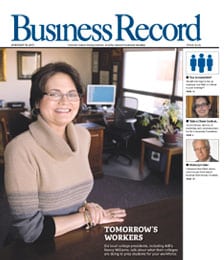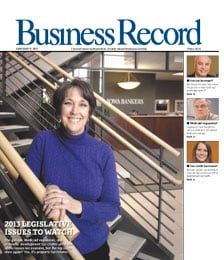Succession planning not just handing the keys over; it’s driver’s ed

Turning over the company to a new CEO can be a lot like teaching a teenager to drive.
“For a while, they ask you for the keys,” said John Hughes, who coaches companies on leadership development and succession training for RSM McGladrey Inc. “Then, pretty soon, they’re just taking them. It’s the perfect analogy, because eventually, if you’ve chosen the right person, they’re going to take the keys, and they’re not giving the car back,” he said.
The aspect of succession planning that many CEOs discount is just how personal the transaction is, Hughes said. “And that’s why many tend to put it off. You have to give up something that’s a part of you, something that you love.”
Companies need to consider business succession more as a process rather than an event, Hughes told a group of about 150 business leaders during a “Power Breakfast” event held June 13 at the Des Moines Club.
The event featured a panel discussion with four executives – Glenn De Stigter, chairman of The Weitz Co., Tom Godlasky, president, chairman and CEO of AmerUs Group Co., John Joseph, vice president of Josephs Jewlery, and Rich Willis, president of Betts Auto Campus — participating. Moderating the event, which was hosted by the Des Moines Business Record, was Thom Powell, Meredith Corp.’s organizational excellence leader.
Hughes said choosing a successor can be particularly challenging because that person must possess the skills to deal with businesses that are becoming increasingly complex.
“That’s where you have to look for your next leader; the person who can deal with the complexities of 10 years from now, not now,” he said.
Godlasky, who recently succeeded Roger Brooks at AmerUs, said he didn’t always have an appreciation of the company’s succession process, which regularly assesses each management team member in 16 performance areas.
Shortly after Godlasky was named to his present position, one of the first tasks given to him by the board of directors was to update the succession plan, he said.
“I can’t emphasize enough the need for communication,” he said. “Making sure that the lines of communication are open so that people can anticipate [the succession] and adapt to it.”
Those lines of communications are equally important in the succession planning of a family-owned business, said Willis, who bought Betts Auto Campus in 2000 from another second-generation business owner.
“What I learned as a second-generation dealer was that I really needed to go from a plan to a process,” Willis said. “I didn’t want the business to create friction in the family.” Conducting regularly scheduled family business meetings allowed the business to be separated from the family so that both could be successful, he said.
Having a buy-sell agreement in place has served Josephs well through several family members’ retirements, Joseph said. Additionally, the company established standards each family member must meet to enter the business, including the completion of a four-year degree and acquisition of skills that benefit the company, Joseph said.
De Stigter, who recently joined the ranks of retired CEOs, said another major consideration is to closely monitor family members who weren’t selected for the top spot to determine whether they should be provided new opportunities within the company.
At an employee-owned company such as Weitz, having independent, outside board members is valuable both to hold management accountable and to execute a well-defined interview and selection process, DeStigter said. “I think they did some things that got us on the right path right quick,” he said.






